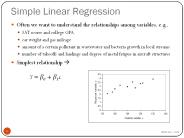Assessment of Low-Dose Dose-Response Relationships (Non-linear or Linear) for Genotoxicity, Focused on Induction of Mutations - PowerPoint PPT Presentation
1 / 16
Title:
Assessment of Low-Dose Dose-Response Relationships (Non-linear or Linear) for Genotoxicity, Focused on Induction of Mutations
Description:
Assessment of Low-Dose Dose-Response Relationships (Non-linear or Linear) for Genotoxicity, Focused on Induction of Mutations & Clastogenic Effects – PowerPoint PPT presentation
Number of Views:199
Avg rating:3.0/5.0
Title: Assessment of Low-Dose Dose-Response Relationships (Non-linear or Linear) for Genotoxicity, Focused on Induction of Mutations
1
Assessment of Low-Dose Dose-Response
Relationships (Non-linear or Linear) for
Genotoxicity, Focused on Induction of Mutations
Clastogenic Effects
- ARA Case Study 26
- Team
- L.H. Pottenger, M.M. Moore, E. Zeiger, T. Zhou
Disclaimer this does not represent the views or
policy of US FDA
2
Case study 26-G/M
- WHAT Dose-response for genotoxic effects from
DNA-reactive chemicals - WHY Driver for risk assessment
- HOW Review published data vs. guidance on
recommended data/approaches - Conclusions Issues
3
WHAT WHYLow-Dose Dose-Response for Genotoxic
Effects
- Definitions
- Low-Dose Range of human relevance (not MTD)
- Mutation Heritable change in genetic information
(gene mutation chromosomal event such as
reciprocal translocation) - Included clastogenicity (micronucleus) data (not
heritable) - Non-linear/threshold Threshold is a subset of
non-linear - Endogenous/Background for adducts genotoxic
effects - Genotoxic effects are a driver for decisions on
cancer risk assessment dose-response models
(mutagenic MOA) - Dose-response of key events is critical input
into MOA analysis (mutation is early key event in
mutagenic MOA) - Shape of dose-response for key events should be
empirically defined with chemical-specific data,
when available, and supported with
hypothesis-driven theory
4
HOW Our Process
- Discussed possible criteria
- Based on
- Pottenger Gollapudi, 2010
- Swenberg et al., 2008
- Several datasets preferred (different labs is
best) - Adequate doses, replicates controls
reproducible results - Preferably with dosimetry data
- Apply dose-response modelling techniques
- Statistical parameters to determine best fit
- Selected assigned candidate chemicals
- EO, EMS/ENU, MMS/MNU, Acrylamide/Glycidamide
- Shared relevant publications
- Developed chemical-specific appendices
- Agreed general conclusions
- Identified issues
5
Conceptual Key Events Frameworks
Mutation
Cancer
Pottenger Gollapudi, 2010
Swenberg et al., 2008
6
Conclusions
- Apparent linearity for biomarkers of exposure
(hemoglobin DNA adducts). - EMS(/ENU) Hb DNA adducts
- MMS(/MNU) DNA adducts based on 13C-MMS
- EO inadequate data not clear if low-dose linear
or not (14C-EO AMS data) - Clear, statistically supported evidence for
low-dose non-linear/threshold dose-response for
induction of mutations and clastogenicity for at
least some DNA-reactive chemicals. - EMS in vivo in vitro statistical best fit for
non-linear/threshold dose-response model - MMS/MNU in vitro statistical best fit for
non-linear/threshold dose-response model
7
EMS in vivo dosimetry
Gocke and Muller, 2009
Apparent linearity for in vivo induction of
protein (hemoglobin) and DNA (N7-ethylG)
adducts by EMS
8
EMS in vivo clastogenicity
Gocke and Muller, 2009
Clear, statistically supported evidence for best
fit of low-dose data on in vivo induction of
clastogenicity by EMS to non-linear/threshold
dose-response model.
9
EMS in vivo clastogenicity dosimetry
Gocke and Muller, 2009
Clear, evidence for low-dose non-linear/threshold
dose-response for in vivo induction of
clastogenicity by EMS, even at doses with
increasing internal dose (Hb adducts).
10
EMS in vivo mutation
Gocke and Muller, 2009
Clear, statistically supported evidence for
low-dose non-linear/threshold dose-response for
in vivo induction of mutation by EMS.
11
Issues
- Current effort was a limited analysis of
available data (with time expertise
constraints) - Develop hypothesis (theoretical underpinnings) to
explain a non-linear/threshold dose-response for
genotoxicity - Only a few examples evaluated statistically
supported best fit of dose-response models. - Additional evaluation (i.e., statistical
approaches to dose-modelling) should be
considered - Additional examples/datasets are always useful
- Eventually develop categories based on MOA/key
events hypothesis-driven theoretical
understanding of MOA
12
- Questions?
13
Endogenous/Background DNA adducts
Endogenous DNA Lesions / Cell
Abasic Sites 30,000
N7-HEG 3,000
8-oxodG 2,400
7-(2-Oxoethyl)G 1,500
Formaldehyde (N6-HOCH2-dA) 960
AcrdG 120
M1dG 60
N2,3-eG 36
1N2-edG 30
1N6-edA 12
TOTAL 38,118
J. Swenberg, personal communication
14
EMS in vivo mutation clastogenicity
Gocke and Muller, 2009
Clear, statistically supported evidence for
low-dose non-linear/threshold dose-response for
induction of mutation and clastogenicity by EMS.
15
MMS and MNU in vitro mutation dosimetry
Pottenger et al., 2009
16
MMS in vitro mutation dosimetry
Swenberg et al., 2008 Doak et al., 2007






























